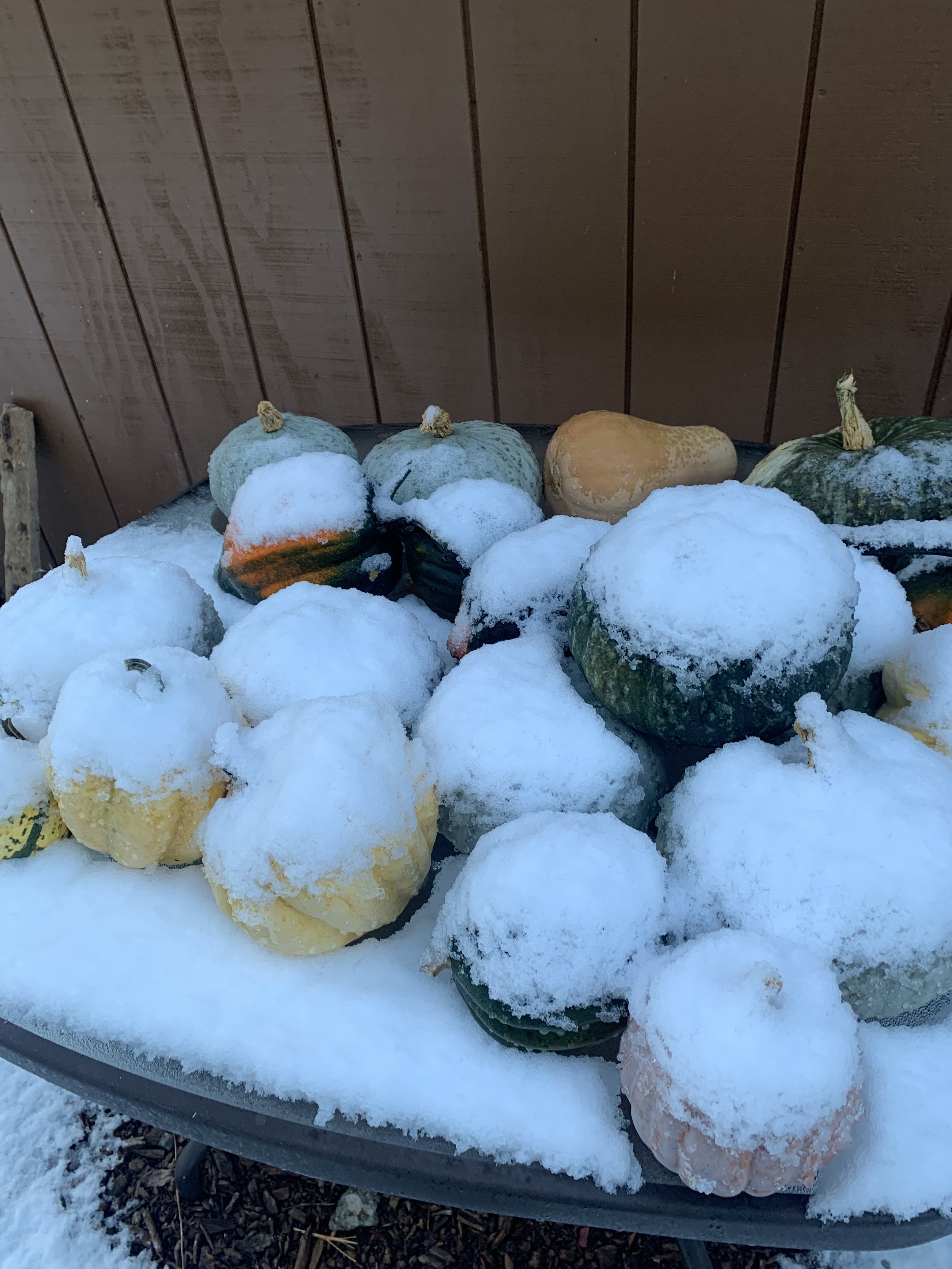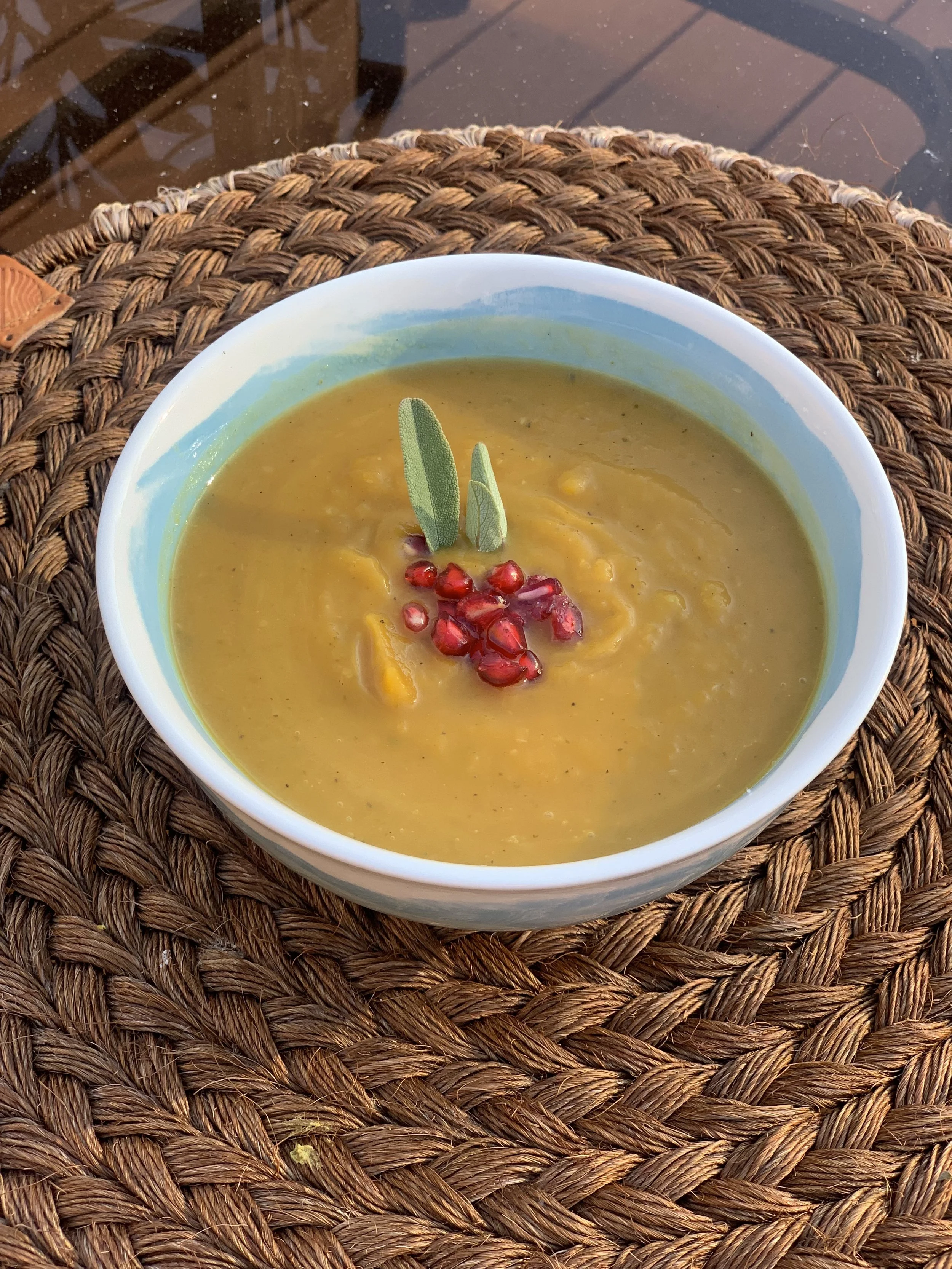Winter Squash Soup with Sage and Pomegranate seeds (and why you should eat more winter squash)
You know, when you get your first asparagus, or your first acorn squash, or your first really good tomato of the season, those are the moments that define the cook's year. I get more excited by that than anything else.
Are you a fan of winter squash? If not, then this may change your mind.
I’ve created a recipe for you to try. If you’re eager to check out the recipe first, scroll to the bottom for my Winter Squash Soup with sage and pomegranate seeds. It’s the perfect winter soup.
Now that I live in an area that SNOWS…I really appreciate my abundance of winter squash. Our first snow came early this year and pretty much wiped out my garden. As the snow melted, I could start to make out the bright orange, green and peanut butter of my winter squash. They were undeterred by the snow and I hastily collected them and brought them in. I didn’t want any hungry critters to start nibbling on these near perfect vegetables.
My garden was a bounty of beauty and delicious, organic vegetables this summer. I over planted and worked hard to keep up with the constant flow of food. We froze, canned, dehydrated, gorged and gave away the extras. The most amazing thing about winter squash is that it doesn’t go bad for a long time….thus the name Winter Squash, as you will be eating it through the winter. And eating it we are!
We have butternut, honey nut, blue kabocha, acorn, spaghetti, pumpkins and some I’m not sure of the names. I can’t say I was a huge fan of these hard to cut, heavy, often weird looking vegetables in the past, but I sure am now!!! With a little effort, I have learned to integrate these beauties into our cooking routine and I find myself craving them almost every night. They are so versatile.
Here are some reasons and ways to integrate these squash into your meal rotation.
Acorn Squash is a good source of vitamin A, magnesium and potassium and is high in vitamin C. You can cut it in half and roast and it is the perfect bowl size to stuff or just add some butter, salt and pepper and eat. We like this as a side, stuffed and reheated or made into a soup. The skin of this squash is edible, so don’t hesitate to eat the whole thing.
Butternut Squash is one of the richest in Vitamin A as well as high in C, B vitamins, magnesium and potassium. This squash is my favorite for making soup because of it’s subtle sweetness and creamy texture when pureed. This is also a great squash to peel and dice and use in recipes like Dal or bean soups. You can also roast the peeled and diced squash with other veggies like Brussel sprouts and carrots for a lovely side or part of a bowl creation.
Spaghetti Squash may not have the high vitamin content of it’s friends Butternut and Acorn, but it is high in fiber and really fun to eat like pasta. When cooked, the flesh pulls apart in strands and resembles angel hair pasta. It can be used as a healthy substitute in pasta dishes or added to pasta.
Kabocha Squash may be less familiar to you, but it is a standout with it’s bright green skin and yellow/orange flesh. It has similar nutritional value to the Acorn Squash and can be used interchangeably in recipes. The skin is edible which makes it a great choice for slicing and roasting. Like all winter squash, kabocha is rich in fiber, which makes it great for gut health.
Winter Squash Seeds are edible and when roasted, make a high fiber, filling snack. i honestly thought you could only eat pumpkin seeds.
There are many more varieties of winter squash with similar nutritional value and taste. I can’t wait to grow some new varieties next year! Do you have a favorite I should try??
Here’s one of my newest winter squash creations. I used my Flavor Bible book to come up with the flavor combination. I love how it turned out. If you give it a try, please let me know what you think!

Winter Squash Soup with sage and pomegranate seeds
Ingredients
- 2 small or 1 large Butternut or Acorn Squash
- 2 Tbsp organic olive oil
- One large yellow onion
- 2-3 cloves minced garlic
- 1 tsp fresh or dried thyme
- 2 bay leaves
- 2 tsp dried sage
- About 6 cups chicken bone broth (preferably homemade)
- 1-2 Tbsp Maple syrup (depends on how sweet you like it)
- Salt and pepper to taste
- Pomegranate Seeds (optional)
Instructions
- Preheat oven to 350* and line a baking sheet with parchment paper.
- If using small squash, poke a few holes in them with a sharp fork or knife and place on the baking sheet. If using a larger squash, you'll need to cut in half and place cut side down on the baking sheet. Bake for 45 minutes or until easy to pierce with a fork. You'll want to start this step early enough so the squash is ready when the onions are done.
- While the squash is cooking, add the olive oil to a dutch oven, dice your onion and sauté for about 15 minutes on medium heat.
- When the onion is soft and slightly carmelized add the garlic, thyme, sage and bay leaves and cook for 2 minutes more.
- Scrape the soft squash flesh from the skin and add to your soup. Mix everything up then add your broth and maple syrup. Add additional water if you like a thinner soup.
- Simmer for about 15 minutes. Remove the bay leaves and pureé with an immersion blender or Vitamix (or whatever you blend with)
- Add your salt and pepper to taste
- Sprinkle the pomegranate seeds on top
- Enjoy!


